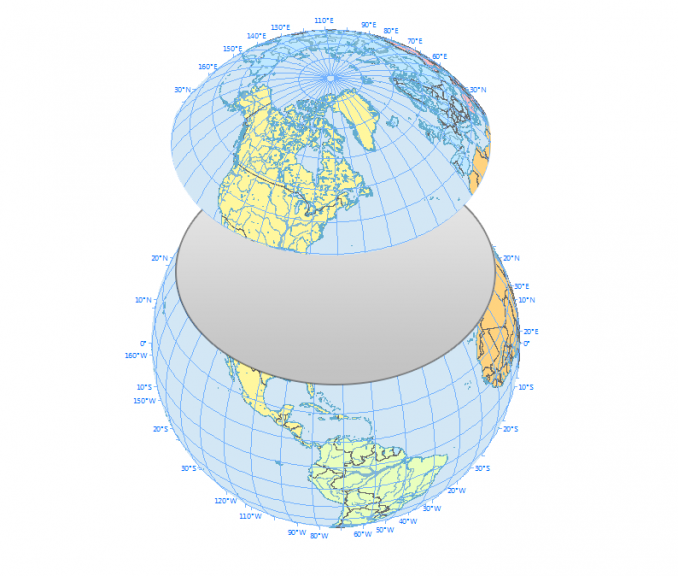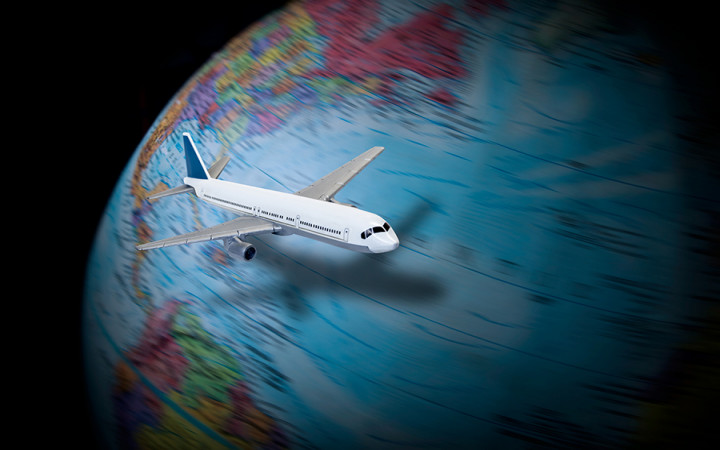Have you ever looked at a flight path on a map and wondered why airplanes take curved routes instead of flying in a straight line? Wouldn’t flying in a direct line be more fuel-efficient and faster? At first glance, it seems logical that a shorter distance would result in less fuel consumption, but in reality, aviation is far more complex.
Several factors determine flight paths, including the Earth’s shape, jet streams, weather conditions, and air traffic regulations. Let’s break down why airplanes rarely fly in a straight line and how their curved paths actually make flights more efficient.
The Earth’s Shape and the Great Circle Route

One of the biggest reasons airplanes don’t fly in a straight line is the Earth’s curvature. While we often view flight maps as flat, the Earth is a sphere, and the shortest path between two points is actually an arc called the Great Circle Route.
If you take a globe and use a string to connect two distant locations, you’ll notice that the shortest route often curves rather than follows a straight path. This is why flights from New York to Tokyo pass over the Arctic region rather than flying directly west across the Pacific Ocean.
Using the Great Circle Route helps planes save both time and fuel, even though it appears curved on a flat map.
Jet Streams and Weather Conditions Impact Flight Paths
Another key factor affecting airplane routes is jet streams—high-altitude wind currents that move at speeds of up to 200 mph (320 km/h). Pilots strategically plan routes to take advantage of these strong winds when possible.
Video : Why Airplanes Don’t Fly Straight
Flying with jet streams allows an airplane to get an extra push, helping it move faster while burning less fuel. Flying against a jet stream can slow down the plane significantly, increasing fuel consumption. Pilots often adjust routes to avoid strong headwinds, even if it means flying a longer distance.
Additionally, storms, turbulence, and severe weather conditions also play a role in determining flight paths. Airplanes may adjust mid-flight to bypass dangerous weather zones, thunderstorms, or areas with extreme turbulence.
Air Traffic Control and Flight Regulations
Air traffic isn’t a free-for-all where planes can just fly wherever they want. There are strict regulations set by aviation authorities and air traffic control (ATC) that dictate flight routes.
Some of these rules include restricted airspace, where certain areas, such as military zones, national security locations, and political zones, prohibit commercial flights from entering. Predefined flight corridors exist to avoid mid-air collisions, ensuring flights follow established air traffic lanes. Major airports handle hundreds of flights daily, so ATC ensures safe and efficient arrivals and departures.
Due to these regulations, airplanes cannot always take the most direct path and must follow designated routes instead.
Avoiding Air Turbulence for Passenger Comfort
Turbulence can make a flight uncomfortable, and pilots actively adjust routes to minimize rough air conditions. There are different types of turbulence, including thermal turbulence caused by warm air rising from the ground. Flying at higher altitudes helps avoid this.

Mechanical turbulence happens near mountains and rough terrains where wind patterns shift unpredictably. Clear-Air Turbulence (CAT) is sudden, strong air currents in high altitudes that are difficult to predict.
To ensure a smoother ride for passengers, pilots may deviate from the shortest path to avoid these turbulent areas.
Why Do Airplanes Sometimes Ascend Before Landing?
If you’ve ever been on a flight where the plane suddenly climbs just before landing, you might have felt a bit concerned. This maneuver is known as a go-around and is actually a common and safe aviation practice.
Some reasons why pilots perform a go-around include runway clearance issues. If another plane hasn’t cleared the runway in time, pilots must abort the landing and circle back. Poor weather conditions, such as poor visibility, strong crosswinds, or sudden gusts, can make a landing unsafe. If a plane is too fast, too high, or not properly aligned with the runway, the pilot will ascend and try again for a safer landing.
Go-arounds are standard procedures in aviation and ensure passenger safety above all else.
The World’s Longest Non-Stop Flight
While most flights follow curved paths, some routes push the limits of non-stop travel. The longest direct commercial flight in the world is from Singapore to Newark, New Jersey, USA.
This flight covers a distance of 10,400 miles (16,700 km) and takes approximately 18 hours and 45 minutes. It follows a carefully optimized path to balance fuel efficiency, wind conditions, and passenger comfort.
Video : Does Earth’s Rotation affect the Airplanes Speed & Flight Time
What Happens If a Plane Suddenly Loses Cabin Pressure?
A sudden drop in cabin pressure is often portrayed as a dramatic event in movies, but in reality, pilots are well-trained to handle it calmly.
When this happens, oxygen masks automatically deploy, and passengers should put them on immediately and breathe normally. The plane will descend to a safe altitude where oxygen levels are sufficient for breathing. The flight crew will assess the situation and communicate with passengers.
Losing cabin pressure doesn’t mean the plane will crash—pilots follow strict safety protocols to handle such incidents efficiently.
Final Thoughts: Why Curved Flight Paths Are More Efficient
While it may seem counterintuitive, airplanes take curved routes instead of straight lines to optimize flight efficiency, fuel usage, and passenger safety. Factors such as the Earth’s shape, jet streams, air traffic control, and weather conditions all play a crucial role in determining flight paths.
So next time you’re on a plane and see the route map displaying a curved flight path, remember there’s a lot of science and planning behind it to ensure you reach your destination as safely and efficiently as possible.
Sharpen Your Mind with This Simple Challenge

Have you ever wondered about the true potential of your mind? Our brain is an incredible tool, capable of performing complex tasks and calculations. Yet, we often rely on calculators or external devices for simple math problems. This article introduces a fascinating puzzle that challenges you to rely solely on your mental abilities to solve it. The PuzzleThe challenge is simple but can easily trip up even seasoned problem-solvers. It goes as follows:Start with 1000. Add 40.Add 1000.Add 30. Add another 1000.Add 20.Add a final 1000. Add 10.Most people rush through it, mentally tallying numbers and assuming the total comes to 5000. In fact, the true result is 4100. This discrepancy is due to the way our brain processes the information quickly, often skipping over smaller details. Let’s break down how to solve it step by step to avoid the common mistake. Breaking Down the CalculationLet’s calculate it slowly and deliberately to avoid any confusion: Starting point: 1000Add 40: 1000 + 40 = 1040Add 1000: 1040 + 1000 = 2040 Add 30: 2040 + 30 = 2070Add another 1000: 2070 + 1000 = 3070Add 20: 3070 + 20 = 3090 Add a final 1000: 3090 + 1000 = 4090Finally, add 10: 4090 + 10 = 4100The correct answer is 4100. Simple, right? But why do so many people make the mistake of thinking it’s 5000? Why Our Brain is TrickedThis puzzle is a perfect example of how our cognitive shortcuts can deceive us. When we perform rapid calculations, our brain tends to group numbers in a way that can lead to errors. In this case, the mind often registers the sum of all the 1000s (which would total 4000), and then quickly adds 40, 30, 20, and 10, but often ends up overshooting and arriving at 5000. The confusion occurs when the brain processes these smaller numbers too quickly, sometimes combining them incorrectly.This phenomenon is called cognitive overload. When we try to mentally juggle too much information at once, we start to rely on assumptions and shortcuts rather than precise calculations. The more numbers we add, the more our mind tries to simplify the process—and that’s where mistakes happen.Strengthening Your Mental MathNow that you understand how your brain can play tricks on you, it’s time to work on improving your mental math. The best way to avoid errors like this in the future is to break down calculations into smaller steps and double-check each stage of the process. Here are a few tips to sharpen your mental math skills: Visualize the Numbers: Instead of letting your brain rush through the sequence, try to visualize each step as if you’re writing it down. This can help you keep track of the running total and avoid miscalculations.Practice with Smaller Numbers: Start with smaller numbers and build your way up to more complex calculations. This trains your brain to handle larger sums with greater accuracy.Stay Calm: Cognitive overload often happens when we’re trying to solve problems too quickly. Take a deep breath, slow down, and approach the challenge with patience. Use Estimation: If you’re ever in a situation where precision isn’t critical, estimation can be a useful tool. But in cases like this puzzle, precision is key, so break down the numbers methodically.Practice Regularly: Mental math, like any other skill, improves with practice. Dedicate time to solving puzzles and problems like this one regularly, and you’ll soon notice an improvement in your accuracy.The Importance of Keeping Your Brain SharpJust like physical exercise keeps our bodies healthy, mental challenges keep our minds sharp. Engaging in puzzles like this one strengthens cognitive function, improves concentration, and enhances problem-solving abilities. Regularly challenging your brain with exercises like mental math can also reduce the risk of cognitive decline as you age.In a world where we often rely on technology to do the thinking for us, taking a few moments to solve problems mentally is a great way to reconnect with the power of your own mind. So, the next time you’re tempted to pull out your phone’s calculator, give your brain a chance to do the work instead.ConclusionThe mental math challenge presented in this article is more than just a simple exercise—it’s a reminder of the capabilities our minds possess. While it might be easy to reach for a calculator, solving problems like this one can help keep your brain sharp and engaged. If you found yourself tricked by the 5000-answer mistake, don’t worry—you’re not alone! Just remember, next time, to slow down, visualize, and approach the task one step at a time. You’ll not only get the right answer but also give your brain a healthy workout.



Leave a Reply